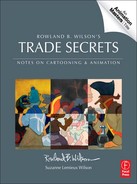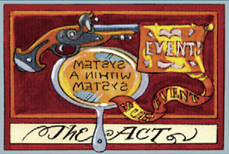
Story: A cause and effect (plot!) series of linked events told (exposition: everything is exposition!) in an uncertain or unpredictable way (suspense, forward motion, foreshadowing, dramatic irony, surprise) intended to involve the audience (empathy, subjectivity!) with the characters to the end (forward motion!) and make a satisfying statement (and statements along the way: the author’s viewpoint can’t be wholly explored in one end-theme) on life. The thematic statement X leads to Y.
Told how? With words expressed by characters and pictures that show the situations: what, where, when, and how (—and why!—).
Story
It’s all about “Story”! This is the heart and the nucleus of the work from which the visualization springs. Whether it is a script, a book, opera, cartoon, game, commercial or illustration—this is your springboard. The act is the basic unit of the story or script and often you will find more than one act. The artist’s job is to translate from written word to the pictorial.
The script is the “written half” and answers the “what,” “why,” “how” and “who.” It contains the plot, exposition or sequence of events, suspense, forward motion, foreshadowing, dramatic irony, surprise and characters. There is usually an overall theme and short themes. The “picture half” is continuity and comprises a number of elements. Character design is akin to actors and acting—who are they and how do they embody the story? Locale illustrates the “where” of the action and often creates and enhances the dramatic mood. Action can be comic, dramatic, entertaining or adventure. Plot themes are the “And then…” of the story, moving along to the next scene.
An additional consideration is the audience point of view. It is important for manipulation of subjective effects, suspense, and empathy in characters and events.

Storytelling: The Point of View
Where To Put Time Camera?
We the audience have to be somewhere in order to see and hear the story.
Sometimes we can hear but not see or see but not hear… for some story reason.

Amateur storytelling puts the camera (audience) in some silly or cute place that draws attention to itself or conversely always puts the audience in the same place regardless.
When you position the audience to look at a scene, imagine you are there. How would you be there? In what capacity?
Would you look down omnipotently?
Look up like a mouse?
Would you be in close like a participant?
Would you be hiding like a voyeur?
Would you be a passerby?
Are you sitting or standing?
Or flying?
Are you short or tall?
Are you one of the characters?
If so, what would you notice?
Why do the good directors put the audience where they do? Always consider if there could be more effective camera/audience work.
The Aspects of Pictorial Storytelling
Subject Matter
1. Genre: The type of story: Romantic Comedy, Drama, Western, Science Fiction, etc.
2. Characters: The performers.
3. Plot: Such as competition for the desired object.
4. Theme: For example: Metaphor, Power, Personal Aggrandizement, Pride, Love.
5. Style: Farce, Operatic, Slapstick and others. (Farce is said to be derived from the word for stuffing… can it be styled in the sense of “stuffed” or “over-overstuffed”?)
Chain of Event
1. Linked together actions written out.
2. Dialogue written into script.
3. Visuals: Main themes of each section indicated as thumbnails establishing atmosphere, look, style.
4. Pacing: Variations and development.
Story Rendition
(Actions, dialogue and visuals woven together by continuities with focal points.)
1. Focal points and themes determined by examination.
2. The Unfolding: Shots and continuities chosen for theme and focus from the diagrams.
Story Themes
(Story themes run from the largest to the intermediate down to the specific.)
1. Overall: The “Grand Scheme.” What is the over-riding concept, philosophy and totality? (Described in a few words or single sentence.)
2. General: Comedy, Suspense, and Action.
3. Specific:
A. Attitudinal such as vindictive, superiority complexes, bluster, greed.
B. Atmospheric: the mystic sea, outer space.
C. Contradictions, such as false love and true love; flawed people in action.
4. Character: Display of personality.
5. Plot: Goals.
Story Focal Points
1. Revelations.
2. Turning Points.
3. Emotional acts and effects.
Story Focus
1. Story Focus means: “The point is this.”
2. Story Focus changes as you go through the story. It can be long or short. (Pages or a panel.)
3. Story Focus can be cross cut:
A. For contrast: Dramatic irony or comic effect.
B. For suspense: Converging with danger; converging with relief.
4. Story Focus can be examined. It should answer the questions:
A. What is happening?
B. What is the most important aspect of what is happening?
C. What is the most satisfying way to show the most important aspect?
i. Is it more satisfying to show the story focus point only?
ii. Is it most satisfying to show the story focus point once or repeat it rhythmically?
iii. Is it more satisfying to show the story focus point in harmony with a story theme or secondary story focus point?
Treatment
1. The treatment is chosen from the list of possible known continuity treatments and pictorial devices.
2. May be invented or combined for special effect.

CHART FOR STORYTELLING FORMS
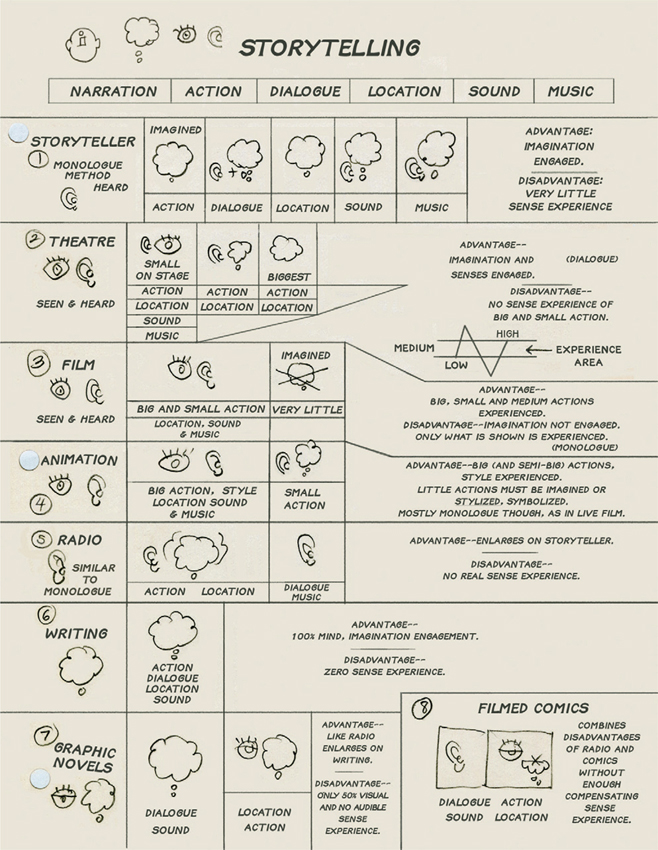
Forms of Storytelling
1. Verbal (Storyteller): Narrator narrates and “dialogues.” Also monologue.
2. Theater Drama
A. Classical: Chorus narrates, actors dialogue and “act.”
B. Traditional: Actors dialogue and “act” within the limits of the set; Reading of play.
i. Performed to written text.
ii. To “improvised” theme.
C. Modified
i. Musical—Actors sing and dance, chorus sings and dances, contains mood music.
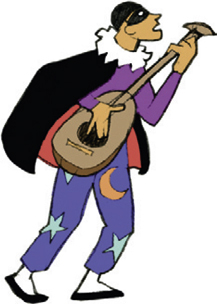
a. Opera—Singing and dancing, orchestral moods:
• Grand Opera, recitative and arias.
• Light Opera, speeches and arias.
• Petty Opera, speeches and recitatives “disguised” as arias.
b. Broadway Musical and Operetta—Popular music in light opera form.
c. Dance Drama—A story told without words. Dance only.
ii. Mime—Story told in gestures only. First cousin to Dance Drama in form.
iii. Puppets—Story told in voices augmented with puppets. First cousin to radio.
iv. Revues—Vaudeville, Music Hall, Pantomime, etc., Part theater, short skits and part concert.
v. Outside of theater—Concerts of all kinds including classical ballet and others that have incidental narrative aspects.
3. Film Drama (Note: All films are to some degree musical.)
A. Silent: Camera “narrates” visually, actors act, dialogue written, no physical limits to the set.
B. Traditional: Same as silent but actors dialogue and mood music.
C. Television: Includes all of film plus filmed drama.
i. Combination
a. Series, soap operas, sit-coms, etc.: Traditional one-act plays with film inserts. Action is mostly stage action.
D. Other: Narration dominated (travelogues, newsreels and instructional; not usually true narrative).
4. Animation: Same as traditional theater drama plus the non-photographical (art-styles, locations, the unreal).
A. Pure Animation
i. Hand-drawn and computer animation.
ii. Puppets, masks and tricks.
B. Animation and Live Action combined (includes drawn animation, computer, masks, special effects, etc.).
5. Radio: Story told in voices only; may include music and sound effects.
6. Writing: Novels and short stories (written narration, written action, written dialogue and written sound effects).
7. Graphic Novels: Comics, “fumeiti,”* everything written except action, which is depicted in stills (seen and imagined).
8. Filmed Comics: Could be considered a television category, “Saturday morning,” limited animation; although considered a subcategory of animation, it is closer to radio writing and especially to puppet shows (a filmed puppet show).
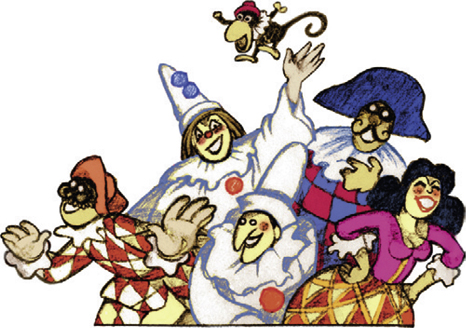
Animation vis-á-vis the Storytelling Forms
What Would Adapt To Animation
1. Storyteller: Animation adapts myths, tales, fables, etc. extremely well. The oral tradition emphasizes character action over inner life and writing style.
2. Theater: Scope is similar but dialogue must all be converted to action. (Action theater is enhanced.)
3. Film: Technique enhanced but character curtailed, emotion curtailed and spectacle curtailed.
4. Radio: In most ways, the antithesis of animation; requires even more adaptation than theater. Puppet shows seem similar to animation but they are opposite.
5. Writing: Not easily adapted. Only the images and action will translate.
6. Graphic Novels: Only a step away. Should be easily adapted.
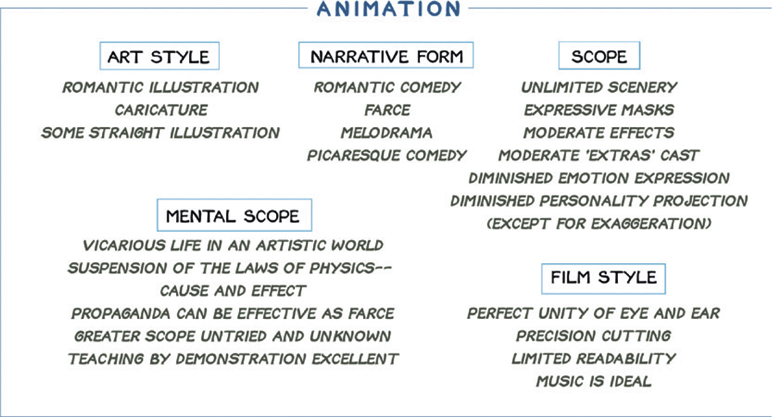
Every great classic has a theme that pre-exists in the reader or viewer. One hour or so is too short a time to generate a concern for the outcome of a story that is external to the concerns of the audience.
You have to find the theme of a classic as a star to steer by. In Victor Hugo the theme is spirituality. Notre Dame is the center of the story, not Quasimodo, Frollo or Esmeralda.
In Hamlet the theme is not wimpy indecision, but the hubris of godlike perfectionism. Hamlet wants everything to be absolutely right: to assume the role of God by judging and condemning.
The result is he destroys more innocents than guilty—Polonius, Ophelia, Laertes and the Queen—and himself if he can be called innocent.
OBSERVATIONS ON COMICS/GRAPHIC NOVELS, STAGE AND FILM I
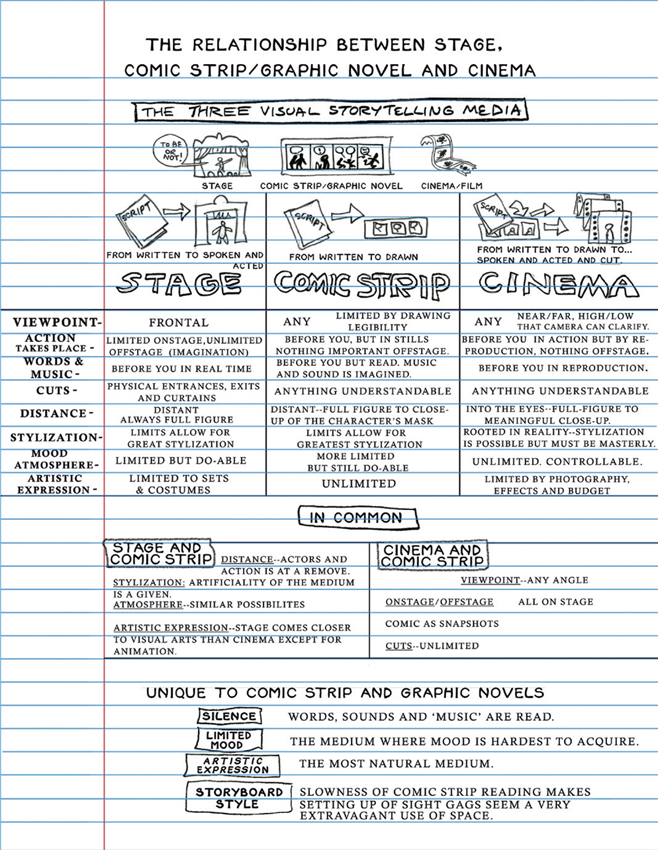
OBSERVATIONS ON COMICS/GRAPHIC NOVELS, STAGE AND FILM II

More Thoughts on “Story”
A plot is a net to catch ideas in.
The quality of a story is not based on the number of characters or the number of events, but on the uniqueness of the two elements.
What makes a character or event memorable?
What makes them entertaining?
What makes them funny?
What does an audience want?
An audience wants the familiar with a twist.
Why? To have a vicarious experience, a pleasurable one.
Why? To forget. To explore a pleasurable and satisfying resolution in a short period of time.
Why do they want the familiar? It is their ticket of entrance. Empathy: “Ah yes, this is so-and-so, I know about that.” The pleasant familiar experience they want to see fulfilled, the appetites. If it is not fulfilled immediately, the appetite for it grows, demanding a greater fulfillment later. The unpleasant experience, they want to see thwarted. If this is postponed, the desire grows to see it thwarted absolutely, once and for all.
How does an audience forget? By having their emotions engaged. The chap is like me; he has to put up with what I do. He likes what I like. He believes what I believe. I fear for him. I love with him. I hate with him. I hope for him. I dare with him.
He sees, hears, feels, smells, tastes as I do.
1. A story is a promise, a wish. Or it is an anxiety, a fear.
2. We feel better when we leave the story. We have seen our wishes materialized—so they seem more real, therefore more attainable. Or our fears materialized—if they do not seem less terrible, they are at least delimited and we have survived them. (If not as the protagonist then as an audience.)
3. To know what will appeal to an audience, know their hopes and fears. Engaging the audience’s emotions is to touch their hopes and fears.
4. The hopes and fears of human being fall into categories. They are:
A. Universal
B. Categorical
C. Temporal
5. Each anxiety has its opposite hope.
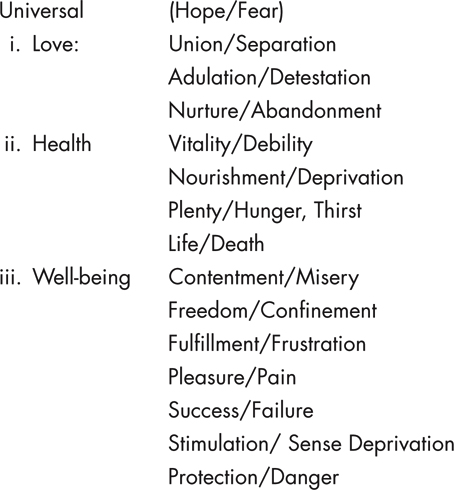
Under Universal, the basic drives fall: Food, Clothing, Shelter, Love, and Play.
B. Categorical: These are the emphasized needs of specific groups—anxieties that special classes of people feel.
i. By Age (children, adolescents, young adults, middle aged, old people)
ii. By Class (destitute, poor, middle class, upper middle class, wealthy)
iii. By Heritage (race, religion, nationality, politics, philosophy)
iv. By Occupation (job, position, role, ambition, interest)
C. Temporal: These are anxieties brought out by the times one lives in.
i. Economic (recession, depression, inflation, boom)
ii. Political (oppression, free-wheeling, wartime, decline, expansion)
iii. Social (repressive, traditional, transitional, highly mobile)
If you examine the times you live in, the hopes and fears of those times lead you to good story material. People are most attracted to the strongest opposites.
In times of fear, do stories of hope and wish fulfillment.
In times of hope, do stories of fear and anxiety.
In times of confusion, do stories with certainties.
In times of disruption, do stories of love and peace.

Systems Within Systems
The striking thing was to dream of having been asleep in a dream—a system within a system within a system.
A system within a system is a useful device. It can create believability by introducing a “real” element into a fictitious environment. It displaces the attention from the fact that everything is imaginary. In literature some classic examples are One Thousand and One Nights and The Canterbury Tales, where you accept that the people authentically exist as you become involved in their stories. It removes the reader from the fact that it already is a story. Art and film essentially are already artifice, so each additional layer can resonate, creating multiple levels of experience.
The Play within a Play
It is two system levels revealed. You believe System One because System Two is so clearly a system. At the same time you can suspend criticism and enjoy a simpler system as a child would.
Dramatic conflict is the clash between two systems. The essential double-bind is created that way. An idea is the congruence and clash of the two systems, a joke—a surprising unity or synthesis.
Shakespeare is full of double systems, as is all theater. We find conflicting loyalties, plays within plays, women disguised as men, and men disguised as women disguised as men.
In art, the image is one system, the brushwork another. Each aspect is a system from composition to color scheme.
Comedy is two related systems at cross-purposes. Satire is the two systems of pretense and reality revealed. A comedy character may be a hypocrite with good pretensions and bad actions, a knave or villain type. Or a comedy character may be compulsive with good intentions and bad habits. Or a character may be a fool, with good intentions but bad execution (mental and physical). Or a comedy character may be a wise fool with good vision and execution.
Any interesting character has a contradiction.
FAVORITE SYSTEMS WITHIN A SYSTEM
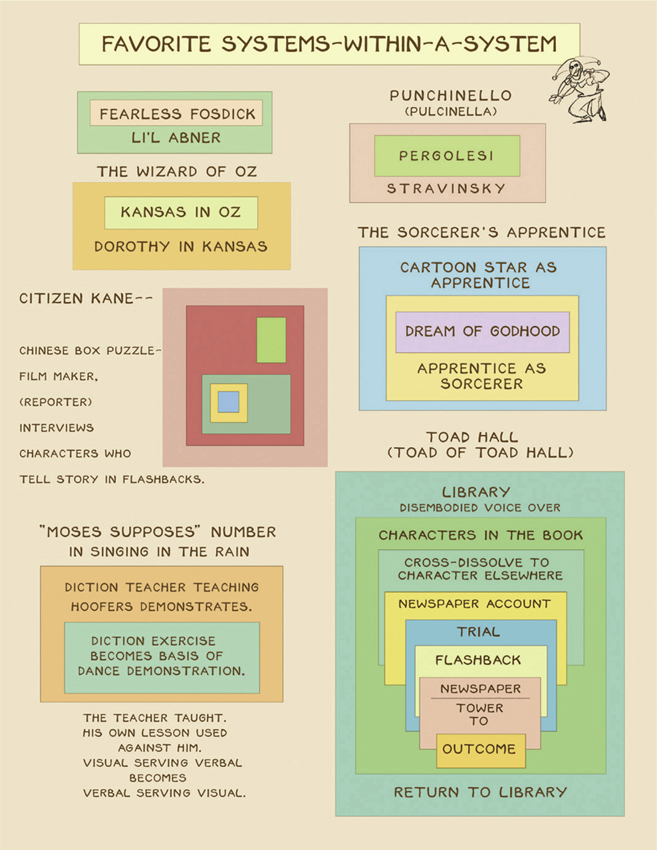
SYSTEMS WITHIN SYSTEMS

THE GRAMMAR OF FILM

GETTING STARTING
A good method is to begin with loose informational drawings to lay out the entire act.
Top: Post-It notes can be used for small quick sketches and are easy to reposition.
Bottom Left: Thumbnail sketches can help to visualize and organize the scenes.
Bottom Right: Example of breaking down the script into its most important features.
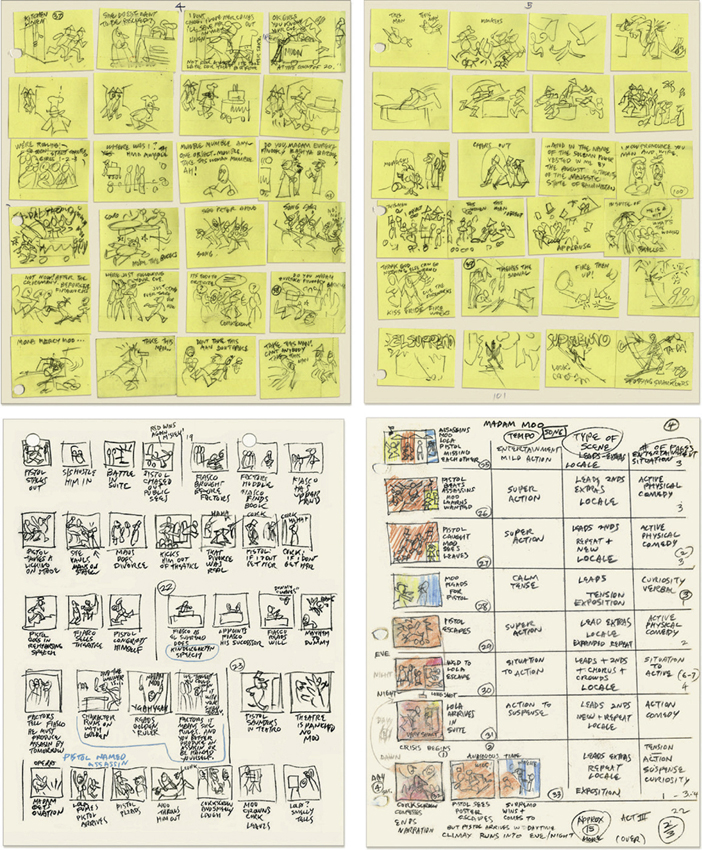

* Note: “fumetti” is an Italian word for comics. It is the plural of fumetto, meaning "little clouds of smok0065" suggesting speech balloons.
